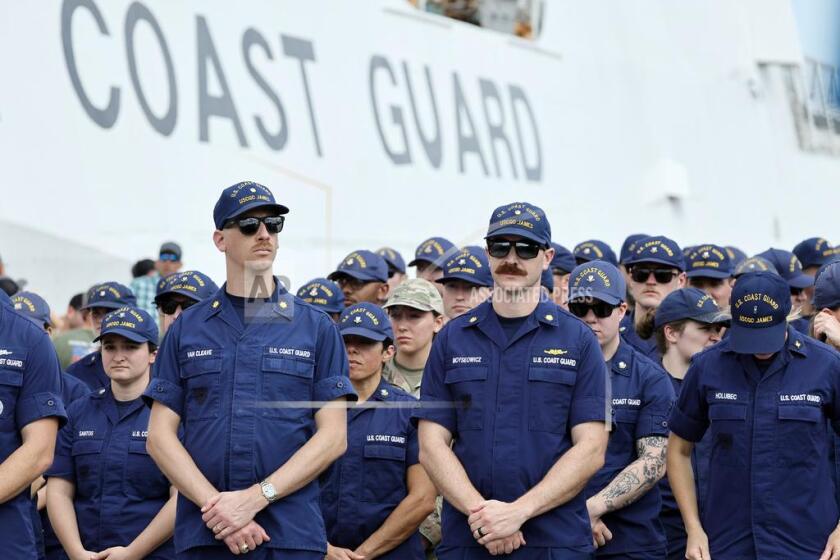America’s ‘Dolphin-Safe’ Lie
- Share via
And now, even dolphins....
Yielding to international pressure, the U.S. government has watered down the popular grocery labeling program that gave consumers a choice to buy “dolphin-safe” tuna fish.
Nobody and nothing, it seems, is safe anymore.
Critics have been warning that globalized free trade will mean the incremental demise of U.S. conservation standards -- and this is proof.
That small but celebrated dolphin-safe logo on cans and packages of tuna in the supermarket? After a dozen successful years, suddenly we cannot count on it to mean what it says.
Here’s what happened: Just before the close of business on Dec. 31, the Bush administration changed the definition of what constitutes dolphin-safe fishing practices. Foreign fishermen are now allowed to chase and encircle dolphins as a short-cut technique to catching the open-ocean yellowfin tuna that school beneath them. Previously, fishermen who harassed dolphins or dropped nets near them were denied the coveted dolphin-safe logo.
The Commerce Department’s National Marine Fisheries Service summarily declared that its change in labeling standards would have “no significant adverse impact” on dolphins.
Actually, chasing and trapping dolphins in nets has plenty of adverse consequences. And the government’s own scientists said so in a 100-page report released simultaneously with the announcement. But to reach its decision, the agency had to ignore these findings, or at least give greater weight to global political forces, including intense lobbying by the Mexican government on behalf of its tuna fleet.
“I had to look at the big picture,” the agency’s assistant administrator, Bill Hogarth, told me.
As he sees it, the big picture is this: If the U.S. did not buckle to pressure and loosen the 1990 labeling requirement, foreign tuna fishermen would simply drop out of the international program that is supposed to protect dolphins and sell their fish elsewhere.
Hogarth said it was wiser to put some dolphins at risk rather than all of them. He notes that under the administration’s revised labeling standards, the on-site killing of dolphins will still disqualify a shipment of tuna from receiving the dolphin-safe label.
Of course, the unseen injury and long-term consequences that occur as dolphins are encircled in closing nets day after day cannot be measured. But who cares? The new labels won’t account for this.
The discouraging -- and foreboding -- thing about this decision is that it upends one of the nation’s most successful and harmonious conservation programs for the shabbiest of reasons.
Thousands of schoolchildren wrote poignant letters on behalf of the dolphins in the 1970s and ‘80s. Their parents followed up by showing their willingness to spend a few extra pennies to support more costly fishing techniques to spare these likable, even lovable, marine mammals. And, significantly, the U.S. tuna processing industry came to embrace, and then vigorously promote, the program. Even grocery chains joined in support of safe tuna.
It is hard to find a better example of the enlightened marriage of conservation and consumerism. The big dogs in the U.S. industry, Chicken of the Sea, Bumble Bee and StarKist, all share a policy of selling only “dolphin-safe” tuna that is truly dolphin-safe.
The pledge was reaffirmed on Jan. 2 by David Burney, executive director of the U.S. Tuna Foundation.
So why undermine the program?
Because the Mexican tuna industry doesn’t want to be told what to do. Because the Mexican fishing fleet and boats from other Latin American countries do not want the expense or bother of alternatives -- like stringing logs on the open sea as a means to mimic the silhouettes of dolphins and attract tuna. Because they don’t want to move to fishing grounds where dolphins are not found. Because they covet the U.S. market but need the dolphin-safe logo to win customers. But most of all because these stubborn old-school fishermen have a powerful ally in the World Trade Organization, which considers conservation in almost any form to be an impediment to trade.
So the dolphins will suffer. Spotted dolphin and eastern spinner dolphin populations are struggling today at only a fraction of their historical levels in the eastern Pacific. Administration scientists concluded “it is likely” that the stress of being targeted by tuna fishermen will make things worse, separating mothers from calves and opening the way for predation by sharks. Surely more will be killed outright as fishing captains feel free to give chase and cast their nets around dolphins.
“This is the poster child for the race to the bottom in global environmental standards,” said Mark Palmer of the conservationist Earth Island Institute. The organization, in an alliance with the Humane Society of the United States, filed suit in federal court to try to block the labeling change immediately after it was announced.
Calling herself “mad, so mad,” California Democratic Sen. Barbara Boxer promised to challenge the decision in Congress. She is the author of the original dolphin-safe labeling law, and in an interview she warned that “if I have to, I’m going to organize the kids of the United States. We did it once before. I’m not going to take this one.”
But less than 48 hours after the regulatory announcement, U.S. officials reported that Mexican tuna was already being shipped across the U.S. border with the new “dolphin-safe” mislabeling.
In the blink of an eye, the gains of a generation were swept aside in the grubby name of globalism. It’s 2003, time to set your watches backward.
More to Read
Sign up for Essential California
The most important California stories and recommendations in your inbox every morning.
You may occasionally receive promotional content from the Los Angeles Times.










